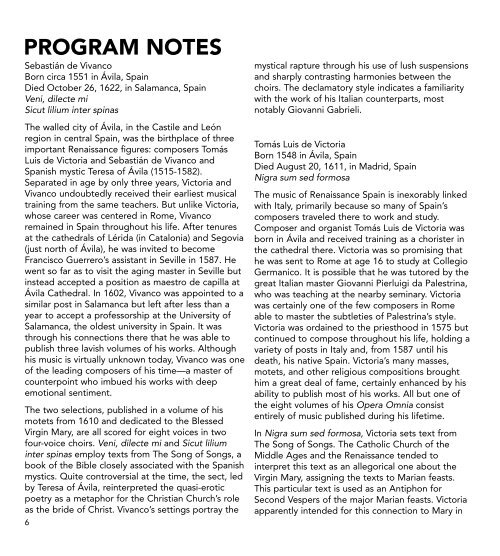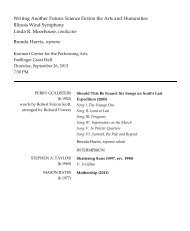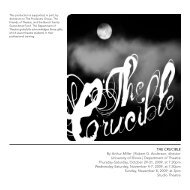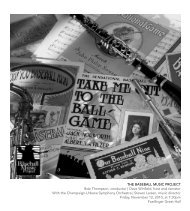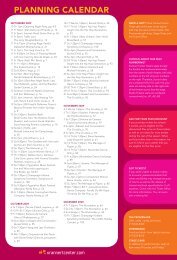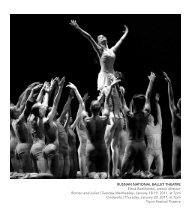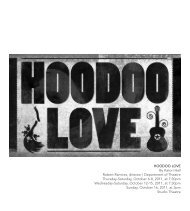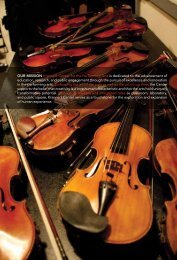Program - Krannert Center for the Performing Arts
Program - Krannert Center for the Performing Arts
Program - Krannert Center for the Performing Arts
Create successful ePaper yourself
Turn your PDF publications into a flip-book with our unique Google optimized e-Paper software.
PROGRAM NOTES<br />
Sebastián de Vivanco<br />
Born circa 1551 in Ávila, Spain<br />
Died October 26, 1622, in Salamanca, Spain<br />
Veni, dilecte mi<br />
Sicut lilium inter spinas<br />
The walled city of Ávila, in <strong>the</strong> Castile and León<br />
region in central Spain, was <strong>the</strong> birthplace of three<br />
important Renaissance figures: composers Tomás<br />
Luis de Victoria and Sebastián de Vivanco and<br />
Spanish mystic Teresa of Ávila (1515-1582).<br />
Separated in age by only three years, Victoria and<br />
Vivanco undoubtedly received <strong>the</strong>ir earliest musical<br />
training from <strong>the</strong> same teachers. But unlike Victoria,<br />
whose career was centered in Rome, Vivanco<br />
remained in Spain throughout his life. After tenures<br />
at <strong>the</strong> ca<strong>the</strong>drals of Lérida (in Catalonia) and Segovia<br />
(just north of Ávila), he was invited to become<br />
Francisco Guerrero’s assistant in Seville in 1587. He<br />
went so far as to visit <strong>the</strong> aging master in Seville but<br />
instead accepted a position as maestro de capilla at<br />
Ávila Ca<strong>the</strong>dral. In 1602, Vivanco was appointed to a<br />
similar post in Salamanca but left after less than a<br />
year to accept a professorship at <strong>the</strong> University of<br />
Salamanca, <strong>the</strong> oldest university in Spain. It was<br />
through his connections <strong>the</strong>re that he was able to<br />
publish three lavish volumes of his works. Although<br />
his music is virtually unknown today, Vivanco was one<br />
of <strong>the</strong> leading composers of his time—a master of<br />
counterpoint who imbued his works with deep<br />
emotional sentiment.<br />
mystical rapture through his use of lush suspensions<br />
and sharply contrasting harmonies between <strong>the</strong><br />
choirs. The declamatory style indicates a familiarity<br />
with <strong>the</strong> work of his Italian counterparts, most<br />
notably Giovanni Gabrieli.<br />
Tomás Luis de Victoria<br />
Born 1548 in Ávila, Spain<br />
Died August 20, 1611, in Madrid, Spain<br />
Nigra sum sed <strong>for</strong>mosa<br />
The music of Renaissance Spain is inexorably linked<br />
with Italy, primarily because so many of Spain’s<br />
composers traveled <strong>the</strong>re to work and study.<br />
Composer and organist Tomás Luis de Victoria was<br />
born in Ávila and received training as a chorister in<br />
<strong>the</strong> ca<strong>the</strong>dral <strong>the</strong>re. Victoria was so promising that<br />
he was sent to Rome at age 16 to study at Collegio<br />
Germanico. It is possible that he was tutored by <strong>the</strong><br />
great Italian master Giovanni Pierluigi da Palestrina,<br />
who was teaching at <strong>the</strong> nearby seminary. Victoria<br />
was certainly one of <strong>the</strong> few composers in Rome<br />
able to master <strong>the</strong> subtleties of Palestrina’s style.<br />
Victoria was ordained to <strong>the</strong> priesthood in 1575 but<br />
continued to compose throughout his life, holding a<br />
variety of posts in Italy and, from 1587 until his<br />
death, his native Spain. Victoria’s many masses,<br />
motets, and o<strong>the</strong>r religious compositions brought<br />
him a great deal of fame, certainly enhanced by his<br />
ability to publish most of his works. All but one of<br />
<strong>the</strong> eight volumes of his Opera Omnia consist<br />
entirely of music published during his lifetime.<br />
<strong>the</strong> liturgical use <strong>for</strong> this piece as he published it in<br />
1576, assigning <strong>the</strong> motet “de Beata Virgine,” or “of<br />
<strong>the</strong> Blessed Virgin.”<br />
Maurice Duruflé<br />
Born January 11, 1902, in Louviers, France<br />
Died June 16, 1986, in Louveciennes, France<br />
Ubi caritas<br />
Jean-Yves Daniel-Lesur<br />
Born November 19, 1908, in Paris, France<br />
Died July 2, 2002, in Paris, France<br />
Épithalame<br />
Plainsong, or Gregorian chant (named after Pope<br />
Gregory I, who died in 604), is <strong>the</strong> term applied to<br />
<strong>the</strong> vast repertoire of liturgical chant assembled over<br />
<strong>the</strong> course of several centuries, roughly AD 700-<br />
1300. There are almost 3,000 extant chants in <strong>the</strong><br />
Gregorian repertoire, with texts specific to each day<br />
of <strong>the</strong> Roman Catholic Church’s liturgical year.<br />
Composers Maurice Duruflé and Jean-Yves Daniel-<br />
Lesur both utilized <strong>the</strong> flowing melodies of Gregorian<br />
chant in <strong>the</strong>ir choral works.<br />
Duruflé, a French composer and organist, was born<br />
in Louviers in 1902. Beginning in 1920, he studied at<br />
<strong>the</strong> Paris Conservatory, where he was later appointed<br />
professor of harmony (a position he held until 1969).<br />
He was very critical of his own compositions and<br />
wrote very few works as a result. Duruflé had a<br />
unique ability to maintain <strong>the</strong> supple flow of a<br />
Gregorian chant melody while coloring it with modal<br />
harmonies and polyphony. This technique is<br />
prevalent in Ubi caritas (Where Charity Is), one of his<br />
most per<strong>for</strong>med compositions and <strong>the</strong> first in a set of<br />
four choral pieces called Quatre motets sur des<br />
thèmes grégoriens (Four Motets on Gregorian<br />
Themes). Its text is a hymn of <strong>the</strong> early Western<br />
church now most often heard on Holy Thursday,<br />
during Eucharistic Adoration, and at weddings.<br />
Duruflé combines <strong>the</strong> traditional Gregorian chant<br />
melody with <strong>the</strong> refrain and first stanza of <strong>the</strong> hymn.<br />
Jean-Yves Daniel-Lesur, a French composer and<br />
teacher, was born in Paris in 1908. His mo<strong>the</strong>r was a<br />
composer and a student of Charles Tournemire, from<br />
whom Daniel-Lesur took early organ and composition<br />
lessons. He studied fur<strong>the</strong>r at <strong>the</strong> Paris Conservatory.<br />
In 1936, Daniel-Lesur was—along with Olivier<br />
Messiaen, André Jolivet, Yves Baudrier, and Pierre<br />
Schaeffer—a founding member of <strong>the</strong> group La<br />
Jeune France (Young France), dedicated to a “return<br />
to <strong>the</strong> human” and opposed to <strong>the</strong> neo-classicism<br />
<strong>the</strong>n prevailing in Paris. His collected works include<br />
some 50 mélodies, three operas, four cantatas, a<br />
mass, and more than 30 folk song arrangements, all<br />
speaking to his love of <strong>the</strong> human voice. Le Cantique<br />
des cantiques (The Song of Songs) was commissioned<br />
in 1952 by Radio France. In Épithalame (<strong>the</strong> word<br />
denotes a wedding-day poem), <strong>the</strong> composer<br />
masterfully weaves toge<strong>the</strong>r <strong>the</strong> Gregorian chant Veni<br />
sponsa Christi (Come, Bride of Christ) with one of <strong>the</strong><br />
most beloved verses from The Song of Songs—“Set<br />
me as a seal on your heart”—in an undulating<br />
crescendo to a final, dramatic climax.<br />
Claudin de Sermisy<br />
Born circa 1490 in France<br />
Died October 13, 1562, in Paris, France<br />
Tant que vivray<br />
Clément Janequin<br />
Born circa 1485 in Châtellerault, France<br />
Died 1558 in Paris, France<br />
Toutes les nuits<br />
The two selections, published in a volume of his<br />
Claude Le Jeune<br />
motets from 1610 and dedicated to <strong>the</strong> Blessed<br />
Born circa 1528 in Valenciennes, France<br />
Virgin Mary, are all scored <strong>for</strong> eight voices in two In Nigra sum sed <strong>for</strong>mosa, Victoria sets text from<br />
Died September 26, 1600, in Paris, France<br />
four-voice choirs. Veni, dilecte mi and Sicut lilium The Song of Songs. The Catholic Church of <strong>the</strong><br />
Revoici venir du printemps<br />
inter spinas employ texts from The Song of Songs, a Middle Ages and <strong>the</strong> Renaissance tended to<br />
Madrigals were <strong>the</strong> popular songs of <strong>the</strong><br />
book of <strong>the</strong> Bible closely associated with <strong>the</strong> Spanish interpret this text as an allegorical one about <strong>the</strong><br />
Renaissance. They were sung by amateurs and<br />
mystics. Quite controversial at <strong>the</strong> time, <strong>the</strong> sect, led Virgin Mary, assigning <strong>the</strong> texts to Marian feasts.<br />
professionals alike in a variety of settings. The texts<br />
by Teresa of Ávila, reinterpreted <strong>the</strong> quasi-erotic This particular text is used as an Antiphon <strong>for</strong><br />
often dealt with everyday matters, including food<br />
poetry as a metaphor <strong>for</strong> <strong>the</strong> Christian Church’s role Second Vespers of <strong>the</strong> major Marian feasts. Victoria<br />
and drink, <strong>the</strong> pursuit of love, and death. The<br />
as <strong>the</strong> bride of Christ. Vivanco’s settings portray <strong>the</strong> apparently intended <strong>for</strong> this connection to Mary in<br />
6 7


